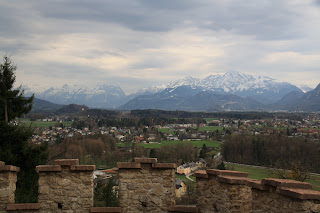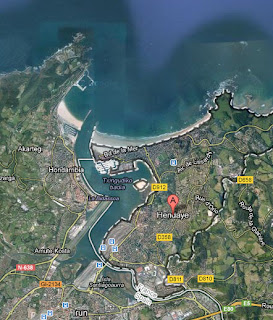 |
| View of Salzburg Suburbs and the Alps |
Salzburg is a smaller Austrian city whose suburbs reach out to the base of the Alps. As with many of the other places we have visited it has a very interesting 'Old Town' where some historic buildings still remain. Some buildings have been preserved and used as an educational tourist attraction while others have been rehabilitated and turned into residences, shops, or restaurants. It is really neat to see modern stores inside a building dating back to the days of Mozart.
On the opposite side of the river from the 'Old Town' lies another gem belonging to this city, Mirabellgarten. Readers who would like to delve more into the history and background of this beautiful garden and the adjacent palace can click HERE; just don't forget to translate the page to your language, unless of course you are fluent in Deutsch. In addition, according to someone on yelp.com and confirmed after a search on YouTube.com, this is where Maria and the children sang 'Do-Re-Mi' in The Sound of Music, and you can take that to Jeopardy.
Although the 'garten' is incredibly beautiful and incorporates several styles of design, I chose to focus on this location for one very particular reason: MAINTENANCE. As a Landscape Architect I find the amount of maintenance that will be required of a completed project tends to make or break a design even in the very early stages. In my opinion this happens A LOT more often than it should.
Let me give you an example. A client hires you to design a park. You attend the initial meetings, get the idea for what they want, visit the project site, list the opportunities and constraints of said site (blah blah blah). Anyways, you get to work; pen flying, mouse clicking, you have brilliant ideas and they are flowing from your brain to you fingers to paper. You come up with a few concepts and take them to the client. You have A) a basic design that simply covers their needs and nothing more, B) a middle of the road design with a little pizzazz and C) the 'creme de la creme' your favorite design providing everything they want and a little more in a very unique, elaborate, but not over the top way. You are excited and really push for design 'C'. They listen to your whole pitch, but choose design 'A' or if you are lucky design 'B', but with some value engineering of course. Why did this happen? Money? Maybe, but more often than not having a project that appears to require more routine maintenance than what a client currently does can make the difference between designing and building another 'park' and a really unique space that has the potential to draw users from all over.
There are many different areas within Mirabellgarten and all require special attention to keep it looking its best. If you take a look at the map below this gives you an idea of the scale of the garten and diversity (and lavish extent) of styles.
 |
| Mirabellgarten (courtesy of Google Earth) |
The use of materials is simple but incredibly elegant. There are stone paths directly adjacent to lawn spaces. There is steel edging separating the two materials to create distinct separation and sharp lines. In the lawn areas, thin 12" flower beds are planted (every year) with annuals. These beds twist and turn into very ornate designs. In some smaller featured areas around the fountains steel edging is used again to create designs in different colored stone. While we were there we saw workers attaching smaller flowers to stakes in order to get them to grow properly. We also saw workers removing some of the colored stone in certain areas. They were doing this to place soil and install lawn. That's right, in the middle of a bed of stone they were introducing lawn. In the Biz we call that, 'a nightmare.' All of the workers seemed genuinely happy. They also seemed passionate about what they were doing. They could see the end result was a beautiful place that people from all over the world come to enjoy! Take a look at the pictures below to help illustrate all of this.
 |
| One of the Many Entrances to Mirabell Hohensalzburg Castle in the Background |
 |
| Intricate Lawn Areas with Ornate Flower Beds (Beds are Flush with Lawn) |
 |
| Lawn and Flower Areas Trimmed Boxwood Garden in Background |
 |
| Focal Plantings at Sculpture With Stone and Lawn |
 |
| Garten Worker Removing Grey Stone to Install Lawn (He is Smiling I Promise) |
 |
| Ground Level to Show Steel Edging (And Happy Worker) |
 |
| Inner Shape After Removal of Colored Stone Awaiting Topsoil |
 |
| Inner Shape After Removal of Colored Stone Awaiting Lawn (Aforementioned Nightmare, but Gosh it Looks Good) |
 |
| Lawn Area with Multiple Flower Types |
 |
| Boxwoods, Holly Trees and Annuals in Separate 'Garten' Room |
 |
| Boxwood Hedges, Lawn and Stone |
 |
| Another Happy Worker Installing Plant Stakes No Joke This Guy Was Not Just Smiling for the Photo |
 |
| Parting Shot of the Lawn and Flowers |
Please don't get me wrong, not all projects get squashed due to maintenance concerns. However, I do believe that with the right amount of education and the selection of the right people for the job maintenance may not be an issue. To return to the example I gave before it's not all about the client. Yes, it is about what they want in the park, and of course its about whether the funds are in place to construct such a place. However, if the people who will be in charge of maintaining the park do not care about the park, do not have a desire to be educated about how to care for some of the new features in the park, are overwhelmed with the current amount of work to be done, are downright lazy, or any combination thereof, the park will not work. It will be a beautiful work of art on paper, and will look great for about one week after construction. Great places take a lot to keep them that way, but to me the return is obviously worth it.











